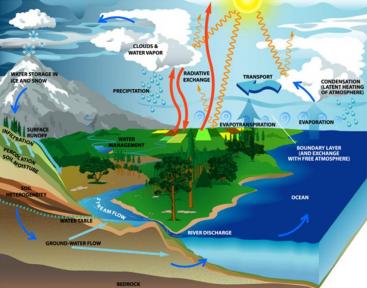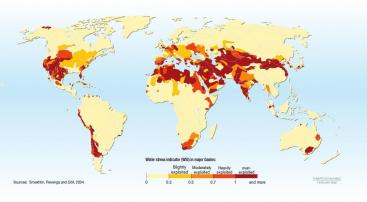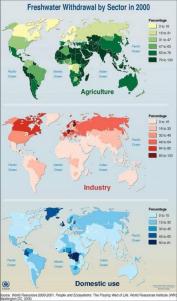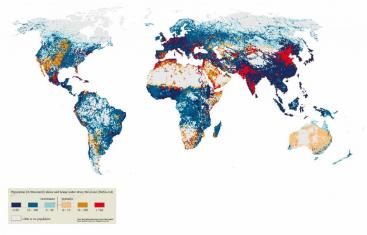Water – essential for life!
Every schoolchild knows that water is essential for life. Yet, many are only just now beginning to grasp how essential it is to everything in life: Growing our foods, cooking and personal hygiene are just the most imminent uses of water. We also use it to produce energy, to transport goods around the globe, as a cultural and social asset – it is necessary for the development of any forms of human life (WBCSD 2010).
The global water cycle
The amount of water on earth has been constant for a very long time. Water travels the earth in a constant cycle through atmosphere, land mass and oceans. Precipitation is the main source of water for all human uses and for ecosystems; its main driver is the sun. Precipitation is taken up by plants and soils, evaporates into the atmosphere via evapotranspiration, and runs off to the sea via rivers, and to lakes and wetlands. This water supports forests, rain-fed cultivated and grazing lands, and ecosystems. Some of the precipitation can be stored for centuries in snow and ice, and some of it can also be stored temporarily in aquifers before it again comes out (springs, pumps etc.). However, most water falls back into the oceans or lands as rain, where it flows over the ground as surface runoff and again flows into rivers and eventually the sea (WWAP 2003).
Freshwater resources

The Water Cycle. Water travels the earth in a constant cycle, which is ultimatively driven by the sun. Source: OWENS (2006)
The earth is called the blue planet – more than 70% of its surface is covered by water (PIDWIRNY 2006). Although water is the most widely occurring substance on earth, only ca. 2.5% is freshwater while the remainder is salt water. Some two thirds of this freshwater is locked up in glaciers and permanent snow cover (see graph below). In addition to the accessible freshwater in lakes, rivers and aquifers, man-made storage in reservoirs adds a further 8,000 cubic kilometres (km3). Water resources are renewable (except some ancient aquifers), with huge differences in availability in different parts of the world and wide variations in seasonal and annual precipitation in many places (WWAP 2003).
Freshwater Distribution

The world’s freshwater resources. Source: WBCSD (2009)
Freshwater is distributed very unevenly over the world. Fewer than 10 countries possess 60% of the world’s available freshwater supply: Brazil, Russia, China, Canada, Indonesia, U.S., India, Columbia and the Democratic Republic of Congo. And even in those countries, the availability varies greatly (WBCSD 2009). Only 80% of the worlds population are served by renewable and accessible water; a fifth of the world population relies on ancient aquifers (aquifers that are not renewed any more presently), interbasin transfers or on desalinised seawater (WWAP 2009).

Water Scarcity Index: The above maps show the exploitation of water resources on the world. The darker the colour, the more water is exploited and the higher is the water stress in that area. Source: REKACEWICZ (2009)
Today, a quarter of the world’s population is affected by physical water scarcity – mainly in northern Africa, the Middle East, and in parts of India, Pakistan and China. This means that there is not enough water for all uses, whether agricultural, industrial or domestic. Defining thresholds for stress in terms of available water per capita is more complex, however, entailing assumptions about water use and its efficiency. Nevertheless, it has been proposed that when annual per capita renewable freshwater availability is less than 1,700 cubic meters, countries begin to experience periodic or regular water stress. Below 1,000 cubic meters, water scarcity begins to hamper economic development and human health and well-being (WWAP 2009).
Human influences on the water cycle
Humans significantly influence the global water cycle, both quantitatively and qualitatively. Concerning quantity, humans withdraw 8% of the total annual renewable freshwater, and appropriate 26% of annual evapotranspiration and 54% of accessible runoff. Humankind’s control of runoff is now global and we are significant players in the hydrological cycle. Per capita use is increasing (with better lifestyles) and population is growing. Thus the percentage of appropriated water is increasing. Together with spatial and temporal variations in available water, the consequence is that water for all our uses is becoming scarce and leading to a water crisis (WWAP 2003).
Local water cycles are also influenced by the way we plan our cities: When land is paved, water cannot soak into the soil. It runs off these hard surfaces very rapidly, so pipes are needed to rapidly carry the resulting large volumes of stormwater to the nearest stream or beach. The result is that streams carry less water or dry up when it is not raining and flood when it does. Pollutants on roads and yards are also swept into waterways (see also sustainable sanitation).

Influences on the water cycle in cities through sealed surfaces. Source: AUCKLAND CITY COUNCIL (2010)
The more humans use water, the more they also influence water quality: Nutrients from fertiliser and from sanitation systems are carried directly into aquatic ecosystems (see nutrient cycle), and also pesticides, industrial pollutants, or medical substances eventually end up in water. As all these substances can be soluble, they also become part of the water cycle (WWAP 2003). Hence, freshwater resources are further reduced by pollution. Some 2 million tons of waste per day are disposed of within receiving waters, including industrial wastes and chemicals, human waste and agricultural wastes (fertilisers, pesticides and pesticide residues) (UNEP & UN HABITAT 2010) (see also soil degradation).
Water uses

The main uses of water are for agriculture, industry and household use. Industrial use of water increases with country income, going from 10% for low- and middle-income countries to 59% for high-income countries. Source: WBCSD (2009)
Agriculture: In many developing nations, irrigation accounts for over 90% of water withdrawn from available sources for use. In England where rain is abundant year round, water used for agriculture accounts for less than 1% of human usage. Yet even on the same continent, water used for irrigation in Spain, Portugal and Greece exceeds 70% of total usage.
Industrial use: After agriculture, industry is the second largest user of water – be it for the production of electricity, as process water, for mining, as a means to dispose or discharge waste etc. The amount varies heavily depending on the type of industries, and so does the pollution resulting from its use.
Domestic use: By now, the water we use directly in our homes accounts for the smallest part of water use – yet it is essential for our survival: for drinking, preparing foods, and for washing ourselves. The consumption varies greatly – for example, from as little as 10 L per person an day in low-income areas in Ulan Bator (Mongolia) (World Bank 2010) to almost 600 L per person and day in the United States (WBCSD 2009). A minimum of 50 L per day as a basic water need is recommended (FALKENMARK 2005; WATER ENCYCLOPAEDIA 2010).
Other uses: Furthermore, also other stakeholders such as fisheries, tourism, or transport use water resources.
See also approaches to optimise water use.
Consequences

Map showing freshwater withdrawal by the different sectors. Source: WORLD RESOURCES INSTITUTE (2000)
Today, a fifth of the world’s people, more than 1.2 billion, live in areas of physical water scarcity, where there is simply not enough water to meet all demands, including environmental flows (WBCSD 2009). “Population growth, changes in lifestyles and living standards, uncontrolled pollution and the effect of climate change result in growing water scarcity in various regions of the world. Competition between humans and between sectors for this essential resource is increasing steadily. It is estimated that by 2030, 60% more food will have to be produced which has important implications on water use and availability. This demand for food, and thus water, is not negotiable” (INFORESOURCES FOCUS 2006).
Outlook

Water-Stress This map shows populations living in water-stressed (red) and relatively unstressed (blue) conditions highlighting substantial within-country differences that national estimates often obscure. higher stress occurs when water availability is less than water demand; lower stress occurs when water availability is higher than demand. Source: WWAP (2006)
Water scarcity is a complex problem - it is one of unsustainable use, sectoral thinking, mismanagement and a lacking and holistic water governance. As so often, it is the life of the poor who are affected most: by water related disease, by degraded and dangerous environments, by a lack of food and water for hygiene. Almost one billion people do not have access to improved water sources, and 2.6 billion do not use improved sanitation options.
Single sector approaches such as wastewater treatment or water management as such are limited in their actions. To save and recycle water, regain resources, to protect ecosystems and to provide mankind with a prosperous and healthy environment, the whole water cycle needs to be taken into account in an integrated, holistic way – linking up sustainable water management sanitation and agriculture.
Stormwater
Sick Water? The central role of wastewater management in sustainable development
This book not only identifies the threats to human and ecological health that water pollution has and highlights the consequences of inaction, but also presents opportunities, where appropriate policy and management responses over the short and longer term can trigger employment, support livelihoods, boost public and ecosystem health and contribute to more intelligent water management.
CORCORAN, E. ; NELLEMANN, C. ; BAKER, E. ; BOS, R. ; OSBORN, D. ; SAVELLI, H. (2010): Sick Water? The central role of wastewater management in sustainable development. A Rapid Response Assessment. United Nations Environment Programme (UNEP), UN-HABITAT, GRID-Arendal URL [Accessed: 05.05.2010] PDFTowards Hydrosolidarity: Ample Opportunities for human ingenuity. Fifteen-Year Message from the Stockholm Water Symposia, in co-operation with the Symposium Scientific Programme Committee Stockholm International Water Institute
Water for Food – a Matter of Survival
The Global Water Cycle has Intensified
Fundamentals of Physical Geography (2nd Edition)
Water Scarcity Index
Facts and Trends. Water (Version 2)
The brochure „Water: Facts and Trends“ by the WBCSD (World Business Council on Sustainable Development) offers a series of appealing graphics a well structured presentation of the main (but not detailed) facts and trends on water and the state of water resources today.
WBCSD (2009): Facts and Trends. Water (Version 2). Geneva: World Business Council for Sustainable Development (WBDSC) URL [Accessed: 20.04.2010]Mongolia. Enhancing Policies and Practices for Ger Area Development in Ulaanbaatar
World Resources 2000-2001: People and ecosystems: The Fraying Web of Life
Water for people – water for life. Executive Summary of the United Nations World Water Development Report 1: Water for people – water for life
Executive summary of the world water development report No. 1 (2003). The Report, a joint undertaking of 24 UN agencies presents a comprehensive picture of freshwater resources in all regions and most countries of the world as it tracks progress towards the water-related targets of the UN Millennium Development Goals. The executive summary is also available in Arabic, French, German, Japanese, Russian and Spanish.
WORLD WATER ASSESSMENT PROGRAMME WWAP (2003): Water for people – water for life. Executive Summary of the United Nations World Water Development Report 1: Water for people – water for life. Paris and Oxford: UNESCO and Berghahn Books URL [Accessed: 17.04.2012]Water – the challenges. Educational Poster Prepared for the United Nations World Water Development Report 1
This poster is very helpful for to giving an overview on the challenges related to water today, including issues such as water stress, sharing water, the different water uses, health etc. The second page of the poster presents some case studies for sustainable water use.
WWAP (2006): Water – the challenges. Educational Poster Prepared for the United Nations World Water Development Report 1. Paris and London: UNESCO and Earthscan URL [Accessed: 27.04.2010]Messages for Youth. The United Nations World Water Development Report 3: Water in a Changing World
This 4-page factsheet provides messages for children and youth and answers questions like: How does the worldwide water situation affect young people? How does the way we use water have an impact on the environment? Youth and water, what can you do?
VELASQUEZ ORTA, S. FURLONG, C. (2009): Messages for Youth. The United Nations World Water Development Report 3: Water in a Changing World. Perugia: United Nations World Water Assessment Programme (WWAP) URL [Accessed: 17.04.2012]Survival Needs
SDG 6 along the water and nutrient cycles
This AGUASAN publication illustrates how the water and nutrient cycles can be used as a tool for creating a common understanding of a water and sanitation system and aligning it with SDG 6.
BROGAN, J., ERLMANN, T., MUELLER, K. and SOROKOVSKYI, V. (2017): SDG 6 along the water and nutrient cycles. Using the water and nutrient cycles as a tool for creating a common understanding of a water and sanitation system - including workshop material. Bern (Switzerland): AGUASAN and Swiss Agency for Development and Cooperation (SDC) URL [Accessed: 26.03.2019] PDFThe Earth’s Natural Water Cycles
This chapter of the third world water development report is dedicated entirely to the water cycle, containing detailed information on water availability, water distributions, and the impact of climate change.
VOROSMARTY, C. J. (2009): The Earth’s Natural Water Cycles. المُدخلات: World Water Assessment Programme WWAP The United Nations World Water Development Report 3: Water in a Changing World: , 166-180. URL [Accessed: 17.04.2012]Facts and Trends. Water (Version 2)
The brochure „Water: Facts and Trends“ by the WBCSD (World Business Council on Sustainable Development) offers a series of appealing graphics a well structured presentation of the main (but not detailed) facts and trends on water and the state of water resources today.
WBCSD (2009): Facts and Trends. Water (Version 2). Geneva: World Business Council for Sustainable Development (WBDSC) URL [Accessed: 20.04.2010]Managing Water by Managing Land: Why addressing land degradation is necessary to improve water productivity and rural livelihoods
This policy brief summarises findings from the publication "Water for food, water for life": A Comparative Assessment of Water Management in Agriculture, 2007, showing that reversing land degradation is an essential step in improving water productivity and rural livelihoods - particularly in low-yielding rainfed systems.
CARRIGER, S. (2007): Managing Water by Managing Land: Why addressing land degradation is necessary to improve water productivity and rural livelihoods. (= Water for Food, Water for Life Issue Brief #10 ). London: Earthscan URL [Accessed: 06.05.2010]Sick Water? The central role of wastewater management in sustainable development
This book not only identifies the threats to human and ecological health that water pollution has and highlights the consequences of inaction, but also presents opportunities, where appropriate policy and management responses over the short and longer term can trigger employment, support livelihoods, boost public and ecosystem health and contribute to more intelligent water management.
CORCORAN, E. ; NELLEMANN, C. ; BAKER, E. ; BOS, R. ; OSBORN, D. ; SAVELLI, H. (2010): Sick Water? The central role of wastewater management in sustainable development. A Rapid Response Assessment. United Nations Environment Programme (UNEP), UN-HABITAT, GRID-Arendal URL [Accessed: 05.05.2010] PDFHighlights of the Global Outlook for Ice and Snow
Ice, snow and climate change are closely linked. The Global Outlook for Ice and Snow investigates those linkages. It also presents information on the trends in ice and snow, the outlook for this century and beyond and the consequences to ecosystems and human well-being of these changes. It covers all parts of the cryosphere (the world of ice): snow, land ice, sea ice, river and lake ice, and frozen ground. The Global Outlook for Ice and Snow was written by more than 70 scientists from around the world. The full report can be downloaded from: http://www.unep.org/geo/geo_ice/
UNEP (2007): Highlights of the Global Outlook for Ice and Snow. المُدخلات: UNEP (2007): Global Outlook for Ice and Snow. Kenya: 7-18. URL [Accessed: 06.05.2010]Part II: A Look at the World's Freshwater Resources
This chapter of the first world water development report provides a good overview of the state of the world’s freshwater resources, the water cycle, and current challenges for water management.
UNESCO & WMO (2003): Part II: A Look at the World's Freshwater Resources. المُدخلات: UNESCO & WMO (2003): WORLD WATER ASSESSMENT PROGRAMME WWAP. The United Nations World Water Development Report 1. Water for People – Water for Life. Paris and Oxford: 67-96. URL [Accessed: 17.04.2012]Water in a Changing World - Overview of Key Messages of the United Nations World Water Development Report 3
Key messages of the world water development report No. 3 (2009). The World Water Development Report (WWDR), the only report of its kind, provides a triennial, comprehensive review and authoritative picture of the state of the world's freshwater resources.
WORLD WATER ASSESSMENT PROGRAMME WWAP (2009): Water in a Changing World - Overview of Key Messages of the United Nations World Water Development Report 3. Water in a Changing World. Paris and London: UNESCO & Earthscan URL [Accessed: 06.05.2019]Water - A Shared Responsibility. Executive Summary of the United Nations World Water Development Report 2
Executive summary of the world water development report No. 2 (2006). The Report, a joint undertaking of 24 UN agencies presents a comprehensive picture of freshwater resources in all regions and most countries of the world as it tracks progress towards the water-related targets of the UN Millennium Development Goals.
WORLD WATER ASSESSMENT PROGRAMME WWAP (2006): Water - A Shared Responsibility. Executive Summary of the United Nations World Water Development Report 2. Water - a shared responsibility. Paris and Oxford: UNESCO and Berghahn Books URL [Accessed: 17.04.2012]Water for people – water for life. Executive Summary of the United Nations World Water Development Report 1: Water for people – water for life
Executive summary of the world water development report No. 1 (2003). The Report, a joint undertaking of 24 UN agencies presents a comprehensive picture of freshwater resources in all regions and most countries of the world as it tracks progress towards the water-related targets of the UN Millennium Development Goals. The executive summary is also available in Arabic, French, German, Japanese, Russian and Spanish.
WORLD WATER ASSESSMENT PROGRAMME WWAP (2003): Water for people – water for life. Executive Summary of the United Nations World Water Development Report 1: Water for people – water for life. Paris and Oxford: UNESCO and Berghahn Books URL [Accessed: 17.04.2012]Productive Sanitation and the Link to Food Security
This factsheet provides information on the link between sanitation and agriculture as well as related implications on health, economy and environment. It shows examples of treating and using treated excreta and wastewater in a productive way and describes the potential for urban agriculture and resource recovery in rural areas. Institutional and legal aspects, business opportunities and how to manage associated health risks are also discussed
GENSCH, R. DAGERSKOG, L. WINKLER, M. VEENHUIZEN, R. van DRECHSEL, P. (2011): Productive Sanitation and the Link to Food Security. Sustainable Sanitation Alliance (SuSanA) URL [Accessed: 09.05.2019]Water Security and the Global Water Agenda
This analytical brief aims to define “water security” and urges to include water security on the agenda of the UN Security Council. It discusses the key aspects of water security (such as climate change, human rights, water food-energy-nexus among others) as well as its policy relevance and policy response options.
UN Water UN Water (2013): Water Security and the Global Water Agenda. Ontario: United Nations University, Institute for Water, Environment and Health (UNU-INWEH) and United Nations Water Programme (UN Water) URL [Accessed: 09.04.2013]Water Security and the Global Water Agenda
This analytical brief aims to define “water security” and urges to include water security on the agenda of the UN Security Council. It discusses the key aspects of water security (such as climate change, human rights, water food-energy-nexus among others) as well as its policy relevance and policy response options.
UN Water UN Water (2013): Water Security and the Global Water Agenda. Ontario: United Nations University, Institute for Water, Environment and Health (UNU-INWEH) and United Nations Water Programme (UN Water) URL [Accessed: 09.04.2013]Water Facts and Trends
This presentation contains some essential graphs and information on the water cycle as such. It is based on the 2009 WBCSD publication “Water Facts and Trends” (see further above).
WBCSD (2009): Water Facts and Trends. (PPT Presentation). Geneva: World Business Council for Sustainable Development URL [Accessed: 20.04.2010]Water – the challenges. Educational Poster Prepared for the United Nations World Water Development Report 1
This poster is very helpful for to giving an overview on the challenges related to water today, including issues such as water stress, sharing water, the different water uses, health etc. The second page of the poster presents some case studies for sustainable water use.
WWAP (2006): Water – the challenges. Educational Poster Prepared for the United Nations World Water Development Report 1. Paris and London: UNESCO and Earthscan URL [Accessed: 27.04.2010]Water Scarcity Factsheet
Thematic Factsheet on Water Scarcity. The world contains an estimated 1 400 million cubic km of water. Only 0.003% of this vast amount, about 45 000 cubic km, are what is called "fresh water resources", i.e. water that can be used for drinking, hygiene, agriculture and industry.
UN Water (2013): Water Scarcity Factsheet. United Nations Water URL [Accessed: 09.04.2019]Project WET
Project WET (Water Education for Teachers) is a non-profit water education program that prepares curricula and materials on various water topics and devotes much attention to training teachers how to use them. The Project WET curriculum and activity guide is available to all formal and informal educators. The program started in the USA but now there are internationally sponsored Project WET programs together with other organizations.
http://ga.water.usgs.gov/edu/watercyclealbanianhi.html
The website of the U.S. Geological Survey contains a labelled image of the global water cycle in over 60 languages.
http://www.youtube.com
If you enter the keyword “water cycle” into youtube, you will find an array of short videos explaining the water cycle, in many different languages, and for different age levels.
http://earthguide.ucsd.edu/earthguide/diagrams/watercycle/
An interactive diagram explaining the water cycle.
Water, Land and People: Voices and insights from three continents
The initiative “Water, Land and People: Voices and insights from three continents“ promoted by the Swiss Agency for Development and Cooperation (SDC) aims at sharing and deepening the knowledge base of SDC and partners in order to improve the development strategies and policies with regard to Integrated Water Resource Management (IWRM) with emphasis on the aspect Water for Food.
http://www.unesco.org/water/wwap/wwdr/
The United Nation’s website for the World Water Development Report (WWDR). This report is released every three years in conjunction with the World Water Forum. It is a comprehensive review that gives an overall picture of the state of the world's freshwater resources and aims to provide decision-makers with the tools to implement sustainable use of our water.
http://maps.grida.no/theme/freshwater
This website contains a number of high-quality maps on different subjects, amongst them also on freshwater availability, water scarcity etc.
http://www.glowa.org/
The GLOWA (Global Change and the Hydrological Cycle) programme is an example of integrative interdisciplinary and application oriented global change research. The aim of GLOWA is to develop simulation-tools and instruments which will allow to develop and to realize strategies for sustainable and future-oriented water management at regional level (case studies in Europe, Africa and the Middle east).
From the Toilet to the Tap: We are all Urine Drinkers
This humorous and simplified infographic demonstrates the water cycle with a focus on drinking water consumed by humankind and therefore how urine travels through the water cycle (taken the scenario of water treatment facilities).

